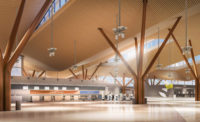Phoenix is building a new transit project that one day will shuttle people at Sky Harbor International Airport from terminal to terminal in air-conditioned comfort.
Sky Harbor officials hope the $1-billion PHX Sky Train will also reduce traffic by nearly 20%, removing 20,000 vehicles from surrounding roadways for less gridlock and pollution.
The initial $625-million, 1.92-mi-long segment will connect the city�s METRO light-rail station at 44th and Washington streets with the airport�s 4,630-space east economy parking lot and 88-gate Terminal 4, which serves 80% of Sky Harbor�s passengers.
Sky Train�s initial segment is expected to attract 28,000 daily riders or 10 million a year upon start-up in the fourth quarter of 2012, airport officials say. A future four-station, 3.08-mi extension will travel from the airport west to the rental car center, drawing an estimated 35 million people annually upon completion in 2020.
Hensel Phelps Construction Co., Greeley, Colo., is the project�s construction manager at risk under a $330-million guaranteed maximum price contact. Gannett Fleming Inc., Camp Hill, Pa., is the facilities design engineer.
�In 2005, we undertook an aviation transportation planning study,� says Gannett Fleming senior project manager Mark Pilwallis. �Sky Harbor was going to be constrained from future growth if it didn�t improve movement.�
The 3,000-acre, three-runway airport is landlocked. An elevated train system, however, offers the advantage of weaving through the airport�s existing infrastructure with minimal disruption while limiting the amount of necessary right-of-way acquisition.
Sky Harbor saved $30 million in property purchases by acquiring a 2-mi-long, six-lane section of State Route 153 that had been an underutilized adjacent roadway. It�s being repaved, widened and incorporated as part of the Sky Train project.
City officials also needed to buy 17 acres of project-related land, relocating 40 businesses in the process.
�We are not a cul-de-sac airport,� says Sky Harbor assistant aviation director Jane Morris. �The Sky Train is the best and cheapest option available that achieves a balance between airfields, terminals and roadways.�
The project calls for 12,000 ft of dual guideway, of which 75% is elevated between 40 and 90 ft. It�s held aloft by 70 reinforced concrete supporting columns 8 ft in diameter. The foundation consists of 80 drilled pylons, 6 to 8 ft in diameter and 50 to 100-ft deep.
Guideway and bridge components are made up of steel, precast and cast-in-place concrete box girders. Hensel Phelps is using an unoccupied two-acre southwest parcel near Terminal 4�s future taxiway as a staging, assembly and laydown area.
The project includes an elevated, 55,000-sq-ft, steel-framed, metal panel and glass-skinned Terminal 4 station that is fully enclosed due to its airfield proximity, plus a 50,000-sq-ft, open-air, metal-canopied platform station at the east economy parking lot.
A new 60-ft-tall, 80,000-sq-ft terminal station at 44th Street will be a three-level steel-framed structure with metal and glass cladding that connects to the city�s METRO light-rail system via a 500-ft-long, 27-ft-tall enclosed box girder pedestrian bridge with moving walkways.
Also to be built is a 100-ft-tall, 350-ft-span Taxiway R Bridge for large aircraft to pass underneath.





Post a comment to this article
Report Abusive Comment